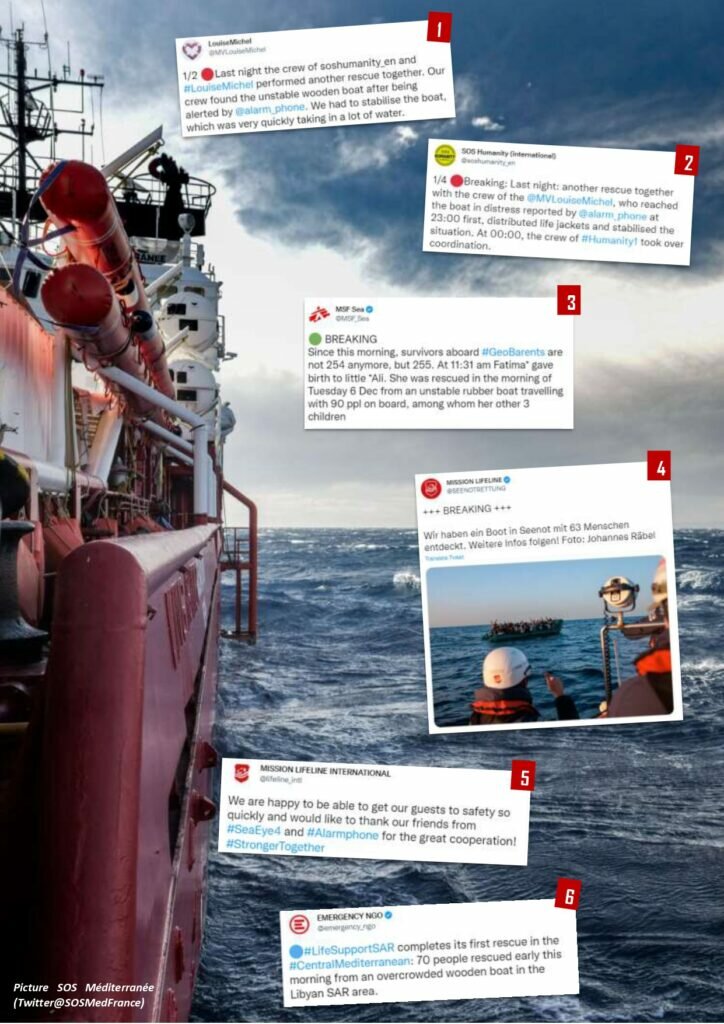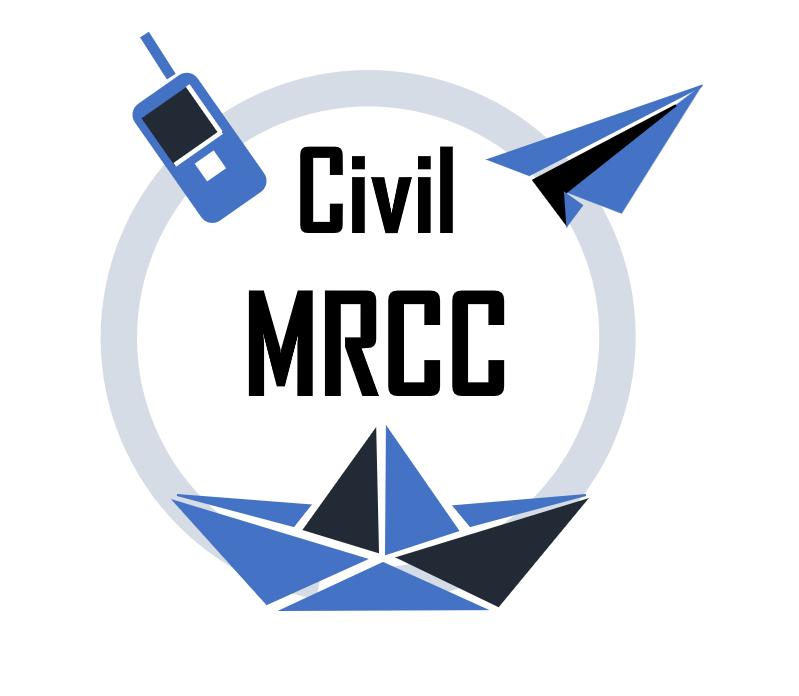| 4 December | Patrolling off the Libyan coast, the Geo Barents rescues 74 people who were travelling in a rubber boat. On the same day, the Louise Michel spots a rubber boat carrying 103 people and assists the group until the better equipped vessel Humanity 1 arrives and takes everybody on board. |
| 5 December | The Alarm Phone receives 2 distress calls from people at sea and alerts both authorities and nearby NGO vessels. 90 people in a rubber boat can be rescued by the Geo Barents, while later at night 49 people in a wooden boat are rescued through joint efforts of the crews of Louise Michel (1) and Humanity 1 (2). |
| 6 December | The aircraft Colibri 2 (Pilotes Volontaires) spots an overcrowded rubber boat and helps the Geo Barents locate the 90 people so that they can be safely embarked (3). The Alarm Phone receives 2 distress calls from people at sea. The Humanity 1 is able to rescue 109 people from one boat while the other boat is violently intercepted by the so-called Libyan Coast Guard. The situation escalates and Humanity 1 is able to save 6 people from the water. One survivor of the interception, reaching out to Alarm Phone after escaping from a detention centre the following day, reports that people went missing during this pushback. During the night, the Louise Michel rescues another boat in distress carrying 33 people. |
| 16 December | The Alarm Phone forwards a distress call from 62 people on a rubber boat. Aircraft Colibri 2 spots the boat and helps the Rise Above to arrive on scene (4). They rescue the persons and transfer everybody to the better equipped Sea Eye 4 (Sea Eye). |
| 17 December | The Rise Above rescues another 27 people. The boat had reached out to Alarm Phone the day before when they experienced engine problems and started drifting (5). |
| 18 December | The Astral (Open Arms) assists a 160-person boat which had reached out to Alarm Phone, until the Italian Coast Guard takes over some hours later. The Life Support (Emergency) conducts her first rescue of 70 people (6). The distress situation was alerted through the Alarm Phone. |
| 19 December | After another alert through the Alarm Phone, the Life Support is able to rescue another 72 people fleeing Libya before heading north to a Place of Safety. |
| 21 December | After having assisted two boats which are later rescued by the Italian Coast Guard, the Rise Above rescues 87 people from two iron boats which departed from Tunisia. Colibri 2 helps in the search for these people after the Alarm Phone is alerted by several relatives of people who tried to reach Lampedusa, but didn’t have satellite phones to communicate on the high seas. |
| 27 December | The Ocean Viking follows an alert via the Alarm Phone and rescues 113 people who left Libya on a rubber boat. Two other boats which reach out to Alarm Phone are intercepted by the so-called Libyan Coast Guard before the Ocean Viking can arrive. |

Focus
05.12.2022 – A joint rescue successfully conducted by ships from the civil fleet, with the so-called Libyan Coastguard behaving aggressively on scene and silence from the responsible authorities
The 49 people on board an overcrowded wooden boat in distress called the Alarm Phone during the night, which then informed the authorities about the situation. The NGO vessel Humanity 1, at 20 nautical miles away from the boat in distress, as well as the faster NGO ship the Louise Michel, both replied that they would change course towards the last position indicated by the people in distress.
At approximately 2200 UTC, the Louise Michel arrived on scene, where the boat in distress was listing and taking on a lot of water, in need of stabilisation by the Louise Michel’s crew. To make matters worse, an armed vessel and crew from the so-called Libyan Coast Guard was also present on scene circling and behaving aggressively, thus endangering the highly delicate situation through their ability to spread fear and panic among the people. After the Humanity 1 also arrived on scene around 1 hour later, the crews of the two civilian vessels were eventually able to conduct a difficult night rescue which resulted in all 49 people being safely embarked aboard the Humanity 1.
The Rescue Coordination centres of Malta and Italy were kept up date on all developments related to this incident by the Alarm Phone and the two ships, but did not at any point step in to fulfil their legal obligations towards undertaking a rescue in this challenging situation, instead staying silent and leaving it once again to civil society to secure the lives and wellbeing of people in distress at sea.
06.12.2022 – A delayed rescue by the Italian Coast Guard ultimately ends positively, with forty people safe in Lampedusa
At around 1600 UTC, an Italian Coast Guard asset located around 40 people stranded on a cliff at the south-western coast of the island of Lampedusa, who had been there since the previous night. Due to the undertow however, the Italian vessel was unable to approach the rocks. The two responsible Italian crew members on board attempted to swim to land but were also unable. The conditions were too dangerous, and the hull and sponson of the Italian asset were at risk of being damaged. This though was not the first time that migrants had arrived at cliffsides, and this group had been stuck for hours, directly in front of authorities who were this time unable to act.
The Italian crew spent more hours of fruitless attempts to reach the people, mostly women and children, who in the meantime lit a fire using the fuel remaining from the trip. Some of the men at one point even attempted to climb the moonlit cliff with bare feet. At around 2300, firefighters approached the cliff from above before giving up due to the height, with the plan to attempt another operation the next morning. At 0630 on the following day, the sea had become calmer. At this point two Coast Guard assets began letting people jump onto an inflatable mattress used as a rescue device, finally shuttling the people to a vessel.
After the arduous journey and then a subsequent 24 hours stuck on the rocks, all the people were eventually rescued, ready to be brought to the Lampedusa hotspot where people tend to spend several days before being transferred to the mainland. This story sadly does not represent an isolated incident – such delays and ineffectiveness in assisting people on the move are representative of a structural crisis in the management of rescue and reception in Italy, where we observe a continuous recourse to “emergency” policies in practice. A system of safe passages and safe rescues both at sea and on land should be outlined, in order to cease the endangering of people as this incident illustrates.
16.12.2022 – Malta orders merchant ships to ignore distress at sea, while the civil fleet steps in once again to undertake a rescue
The 45people on board a fibreglass boat in distress called the Alarm Phone for help while in the Maltese search and rescue region, panicking and requesting an immediate rescue. In subsequent calls to the Alarm Phone, the people then reported seeing at least two cargo ships in their vicinity. While the well-equipped civil fleet vessel the Sea-Eye 4 was also active in the central Mediterranean at the time, the Italian authorities, who had information about the case since the initial alert came from the Alarm Phone on 16.12, instructed the Sea-Eye 4 to sail immediately to Livorno even when it was available with rescue capacity on 17.12.
While the Sea-Eye 4 crew continued attempts to locate the missing persons, the crew was in contact with two merchant ships also in the Maltese search and rescue zone, where it was found that the Maltese Rescue Coordination Centre had instructed both vessels to continue on their regular course rather than attend to the persons in distress. An email from the Maltese Rescue Coordination Centre to the vessel MTM Southport stated that there was no distress case and that a rescue of the people would be considered by the Maltese authorities as an interception on the high seas. Measures to rescue or at least to review the case were not initiated by Malta at any time, where instead, the Maltese authorities seemed actively to try to prevent the rescue.
This is a systematic approach based on political calculations, which has cost human lives several times before. The case of the young girl Loujin, who died of thirst in the Maltese search and rescue zone in September, is just one well-known example of the consequences of this type of deliberate inaction. With the help of MTM Southport however, the Sea-Eye 4 was finally able to find the 45 people, rescuing and safely embarking them.
Nearly all of the people suffered fuel burns and were traumatised by the events. In total, the people were at sea for six days and had to fear for their lives needlessly while in the rescue competency zone of a European state.




